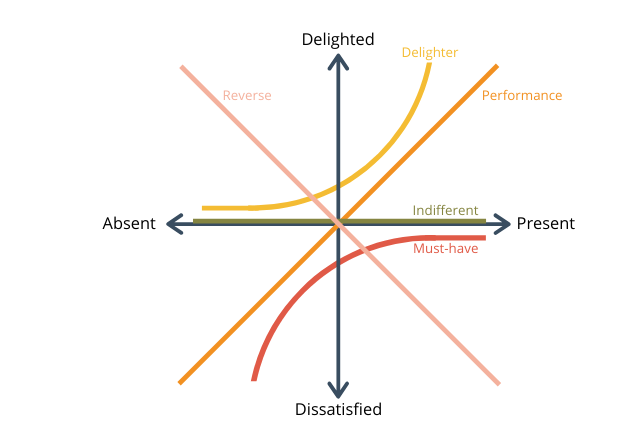Origins
Dr. Noriaki Kano, a professor of quality management from Tokyo University, created the Kano Model in the 1980s. He developed the Kano Model while researching the factors that contribute to customer satisfaction and loyalty. If a customer experiences a high level of satisfaction, they can become excited and get great pleasure or delight.
Kano theorized that a customer’s perception of satisfaction changes over time. Features that bring delight now will later become features that customers expect, and so to maintain customer satisfaction, a product developer must continue to evolve. The Kano model is often used in Six Sigma, as part of the define phase of the DMAIC process.
How it works
The Kano model works by understanding each feature you want to develop based on two axes:
- On the x-axis, we record whether the feature is absent or present within your product or service
- On the y-axis, we record how we expect the customer to respond to the feature (dissatisfied or delighted by the feature)

The next thing the model does is to break this diagram into categories of features:
- Must-have features
- Performance features
- Delight features
- Indifferent features, and
- Reverse features
Must-Have Features
Must-haves are the features that customers expect as part of the product or service. These represent your customer’s basic requirements. These features won’t delight your customers in any way. They will, at best, be neutral to those features. However, your customers will be very dissatisfied if even one must-have feature is absent, then .
As an example, imagine arriving at a hotel room and locking the door behind you as you enter. If you lock the door successfully then you don’t really think about it, it’s just what you expect. But if you arrived to find your room had no door lock you’d be absolutely horrified and dissatisfied.
Put simply, your product or service must have all must-have features or your customer will be dissatisfied. However, having all the must-have features will not delight your customer. You can see this on the diagram because the red must-have line never goes above the horizontal x-axis. Your product must contain these features, you don’t have any choice.
Performance Features
These are features that the more a customer gets of them the more satisfied they are. Performance features improve the performance of your product in some way.
Performance features have qualities like cost, entertainment, ease of use, or security. These are the type of features that customers appraise when assessing whether a product suits their needs. These features result in satisfaction if present and dissatisfaction when they are not.
The straight orange performance line on the diagram shows that for every increase in functionality, there is a proportional increase in satisfaction.
Returning to our hotel example, performance features might include things such as a bigger bed, a bigger TV, or triple-glazing to remove outside noise.
Delight Features
These are features that your customer doesn’t expect but they make your customer delighted if they are present. The yellow “delighter” line in the diagram represents the delight features. If these features are absent then the customer is neutral about it (the line never goes below the x-axis line), but if they are present then the customer is extremely happy.
For our hotel example, this might mean getting a room upgrade when you check-in or finding some champagne and flowers in your room.
Indifferent Features
The green line that runs along the x-axis represents these. Indifferent features are ones the customer doesn’t care about – whether they are present or absent your user just doesn’t care.
In our hotel that might be something like having a rug in your room. If it’s absent you maybe don’t even notice you don’t have one, and if it’s present you don’t really notice it either.
Reverse Features
These features actually annoy your customer if they are present but make your customer happy when not there. The salmon-colored line in the diagram represents them.
Returning for a final time to our hotel example, when you visit the hotel restaurant for breakfast then having to queue before you can be seated is annoying. Far better would be to simply be able to walk in and choose a table. The server could then ask any questions they have after you’ve sat down.
Habituation
How your customer feels about a feature can change over time as customers become habituated to a feature. This is known as the habituation effect. Delighting features can become performance features and eventually must-have features.
For example, in the 1960s your customer might have been delighted to find a TV in their hotel room. In the 1970s, this would have been a performance feature. But, today, it’s considered a must-have requirement.
Advantages
Kano Model helps:
- Organizations understand their customer’s needs better than their customer’s understand their own needs
- You put customer’s front and center by delivering features in the order that your customers most want them
- You to chose the feature with the biggest impact on customer satisfaction when resources are scarce
Disadvantages
The disadvantages of using the Kano Model include:
- Performing a complete Kano analysis can take a lot of time
- It can be hard to describe features to customers in the form of a question. Sometimes your customers don’t know they want something until you show it to them
- Does not consider the cost of building features as part of the model




